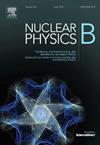Leaf of leaf foliation and Beltrami parametrization in d > 2 dimensional gravity
IF 2.8
3区 物理与天体物理
Q2 PHYSICS, PARTICLES & FIELDS
引用次数: 0
Abstract
This work establishes the existence of a covariant “Beltrami vielbein” in dimensions , generalizing the well-known case. The definition of this vielbein is motivated by a sub-foliation structure of the Arnowitt–Deser–Misner (ADM) slices of a d-dimensional Lorentzian manifold , namely . Here, denotes dynamically varying Riemann surfaces that foliate within each ADM slice. The covariant “Beltrami vielbein” associated with any generic d-bein of is systematically determined via a covariant gauge-fixing of the Lorentz symmetry. It is parametrized by independent fields, which fall into two distinct categories, each bearing a specific interpretation. Importantly, the Beltrami parametrization is not restricted to the ADM framework, it is a general feature that holds in any local coordinate system. The Weyl-invariant sector of the Beltrami d-bein precisely selects the physical local bulk degrees of freedom of gravity for , while retaining some flexibility depending on the specific physical problem considered in the gravitational bulk and boundary. The components of the Beltrami d-bein correspond one-to-one with those of the associated Beltrami d-dimensional metric. The Beltrami parametrization of the spin connection and the Einstein–Hilbert action leads to compact and suggestive expressions, which may facilitate, for instance, the search for new Ricci-flat solutions classified by the genus of the submanifolds . More subtle issues arise in the Carrollian case, where the Lorentzian metric becomes degenerate and the correspondence between the spin connection and the Beltrami vielbein is no longer one-to-one. These aspects will be studied elsewhere, potentially opening interesting avenues for further investigation. Gravitational “Beltrami physical gauges” can be introduced to exploit the geometrical and intuitive advantages of the Beltrami parametrization in specific well-defined physical contexts. Further constraints simplify the Beltrami d-bein expression when possesses a given holonomy group, as exemplified by the case of eight-dimensional Lorentzian manifolds with holonomy. The results obtained in Lorentzian signature can be straightforwardly extended to the Euclidean case, as well as to situations where the foliation is taken along null coordinates, albeit with some subtleties specific to the null case.
叶片的叶理和Beltrami参数化在d > 二维重力
本文建立了维数为d>;2的协变“Beltrami vielbein”的存在性,推广了众所周知的d=2的情况。这一定义是由d维洛伦兹流形Md的Arnowitt-Deser-Misner (ADM)切片的子叶状结构引起的,即Σd−1ADM=Σd−3×Σ2。这里,Σ2表示动态变化的Riemann曲面,在每个ADM切片中叶状分解Md。通过Md -洛伦兹对称的协变量规固定,系统地确定了与Md的任何泛型d-拜因相关的协变“Beltrami vielbein”。它由d(d+1)2个独立的场参数化,这些场分为两个不同的类别,每个都有特定的解释。重要的是,Beltrami参数化并不局限于ADM框架,它是适用于任何局部坐标系的通用特性。Beltrami d-bein的weyl不变扇区精确地为d>;3选择了d(d−3)2物理局部体重力自由度,同时根据重力体和边界中考虑的特定物理问题保留了一定的灵活性。Beltrami d-bein的分量与相关的Beltrami d维度规的分量一一对应。自旋连接的Beltrami参数化和爱因斯坦-希尔伯特作用导致紧凑和暗示的表达式,这可能有助于,例如,寻找新的里奇平面解分类子流形的属Σ2。更微妙的问题出现在卡罗里的情况下,洛伦兹度规变得简并,自旋连接和贝尔特拉米维尔拜因之间的对应不再是一对一的。这些方面将在其他地方进行研究,可能为进一步的研究开辟有趣的途径。重力“贝尔特拉米物理量规”可以被引入,以利用贝尔特拉米参数化在特定的明确定义的物理环境中的几何和直观优势。当Md拥有一个给定的完整群时,进一步的约束简化了Beltrami d-bein表达式,如G2∧SO(1,7)完整的八维洛伦兹流形的例子。在洛伦兹签名中得到的结果可以直接推广到欧几里得情况,以及沿零坐标进行叶化的情况,尽管在零情况下有一些微妙之处。
本文章由计算机程序翻译,如有差异,请以英文原文为准。
求助全文
约1分钟内获得全文
求助全文
来源期刊

Nuclear Physics B
物理-物理:粒子与场物理
CiteScore
5.50
自引率
7.10%
发文量
302
审稿时长
1 months
期刊介绍:
Nuclear Physics B focuses on the domain of high energy physics, quantum field theory, statistical systems, and mathematical physics, and includes four main sections: high energy physics - phenomenology, high energy physics - theory, high energy physics - experiment, and quantum field theory, statistical systems, and mathematical physics. The emphasis is on original research papers (Frontiers Articles or Full Length Articles), but Review Articles are also welcome.
 求助内容:
求助内容: 应助结果提醒方式:
应助结果提醒方式:


